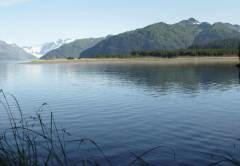CoastsThe characteristics of a coast depend on its geologic structure, initial topographic configuration, and shoreline process that shape it. There are several ways and varying scales one can classify these complex systems. Submerged coasts form when river mouths are flooded due to rising sea level or subsidence of land. A drop in sea level or rise in the land surface creates an emergent coast. Depositional coasts have abundant depositional features like deltas, bars, spits and reefs where new land has been built. Coral coasts are formed by biological rather than physical processes. Submerged CoastsRia coasts
are
formed by the submergence of river valleys emptying into the ocean.
"Ria" is a Spanish term for coasts with prominent headlands and
embayments typical of these coasts. Wave action turns the smooth
valley sides into receding cliffs with
sand spits and
tombolos
common.
Figure 21.19 Kenai Fjord National Park, Alaska Fjord (fiord ) coasts are form when glacial troughs are flooded due to a rise in sea level. Fiord coasts are deeply indented, with steep-walled valleys. Sandy beaches are rare as sediment eroded from valley walls collects on the floor. Fjords are common in Scandinavia, British Columbia, Alaska, and Patagonia. |
